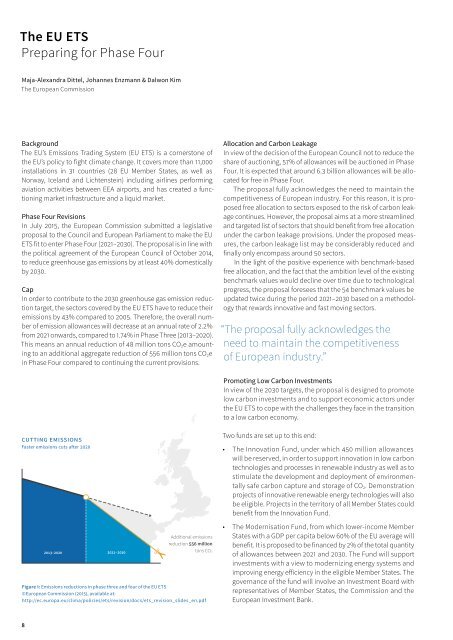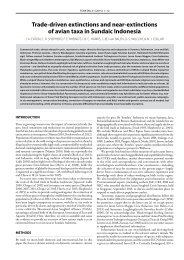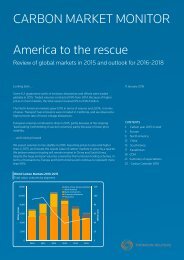Emissions Trading Worldwide
1TbjEHd
1TbjEHd
Create successful ePaper yourself
Turn your PDF publications into a flip-book with our unique Google optimized e-Paper software.
The EU ETS<br />
Preparing for Phase Four<br />
Maja-Alexandra Dittel, Johannes Enzmann & Dalwon Kim<br />
The European Commission<br />
Background<br />
The EU’s <strong>Emissions</strong> <strong>Trading</strong> System (EU ETS) is a cornerstone of<br />
the EU’s policy to fight climate change. It covers more than 11,000<br />
installations in 31 countries (28 EU Member States, as well as<br />
Norway, Iceland and Lichtenstein) including airlines performing<br />
aviation activities between EEA airports, and has created a functioning<br />
market infrastructure and a liquid market.<br />
Phase Four Revisions<br />
In July 2015, the European Commission submitted a legislative<br />
proposal to the Council and European Parliament to make the EU<br />
ETS fit to enter Phase Four (2021–2030). The proposal is in line with<br />
the political agreement of the European Council of October 2014,<br />
to reduce greenhouse gas emissions by at least 40% domestically<br />
by 2030.<br />
Cap<br />
In order to contribute to the 2030 greenhouse gas emission reduction<br />
target, the sectors covered by the EU ETS have to reduce their<br />
emissions by 43% compared to 2005. Therefore, the overall number<br />
of emission allowances will decrease at an annual rate of 2.2%<br />
from 2021 onwards, compared to 1.74% in Phase Three (2013–2020).<br />
This means an annual reduction of 48 million tons CO 2 e amounting<br />
to an additional aggregate reduction of 556 million tons CO 2 e<br />
in Phase Four compared to continuing the current provisions.<br />
Allocation and Carbon Leakage<br />
In view of the decision of the European Council not to reduce the<br />
share of auctioning, 57% of allowances will be auctioned in Phase<br />
Four. It is expected that around 6.3 billion allowances will be allocated<br />
for free in Phase Four.<br />
The proposal fully acknowledges the need to maintain the<br />
competitiveness of European industry. For this reason, it is proposed<br />
free allocation to sectors exposed to the risk of carbon leakage<br />
continues. However, the proposal aims at a more streamlined<br />
and targeted list of sectors that should benefit from free allocation<br />
under the carbon leakage provisions. Under the proposed measures,<br />
the carbon leakage list may be considerably reduced and<br />
finally only encompass around 50 sectors.<br />
In the light of the positive experience with benchmark-based<br />
free allocation, and the fact that the ambition level of the existing<br />
benchmark values would decline over time due to technological<br />
progress, the proposal foresees that the 54 benchmark values be<br />
updated twice during the period 2021–2030 based on a methodology<br />
that rewards innovative and fast moving sectors.<br />
“The proposal fully acknowledges the<br />
need to maintain the competitiveness<br />
of European industry.”<br />
Promoting Low Carbon Investments<br />
In view of the 2030 targets, the proposal is designed to promote<br />
low carbon investments and to support economic actors under<br />
the EU ETS to cope with the challenges they face in the transition<br />
to a low carbon economy.<br />
cutting emissions<br />
Faster emissions cuts after 2020<br />
2013–2020 2021–2030<br />
Additional emissions<br />
reduction 556 million<br />
tons CO 2<br />
Figure 1: <strong>Emissions</strong> reductions in phase three and four of the EU ETS<br />
© European Commission (2015), available at:<br />
http://ec.europa.eu/clima/policies/ets/revision/docs/ets_revision_slides_en.pdf<br />
Two funds are set up to this end:<br />
• The Innovation Fund, under which 450 million allowances<br />
will be reserved, in order to support innovation in low carbon<br />
technologies and processes in renewable industry as well as to<br />
stimulate the development and deployment of environmentally<br />
safe carbon capture and storage of CO 2 . Demonstration<br />
projects of innovative renewable energy technologies will also<br />
be eligible. Projects in the territory of all Member States could<br />
benefit from the Innovation Fund.<br />
• The Modernisation Fund, from which lower-income Member<br />
States with a GDP per capita below 60% of the EU average will<br />
benefit. It is proposed to be financed by 2% of the total quantity<br />
of allowances between 2021 and 2030. The Fund will support<br />
investments with a view to modernizing energy systems and<br />
improving energy efficiency in the eligible Member States. The<br />
governance of the fund will involve an Investment Board with<br />
representatives of Member States, the Commission and the<br />
European Investment Bank.<br />
8




